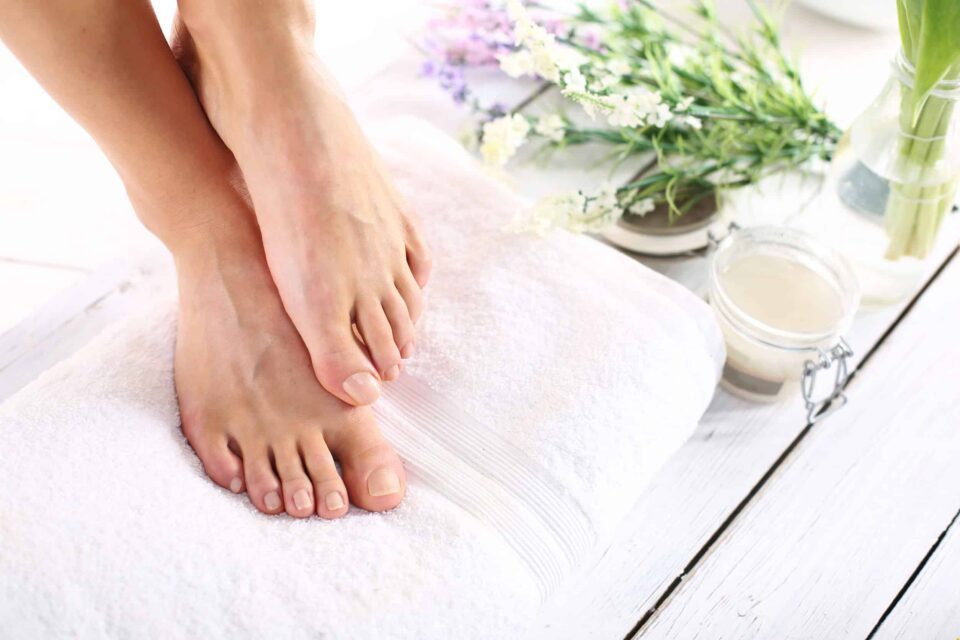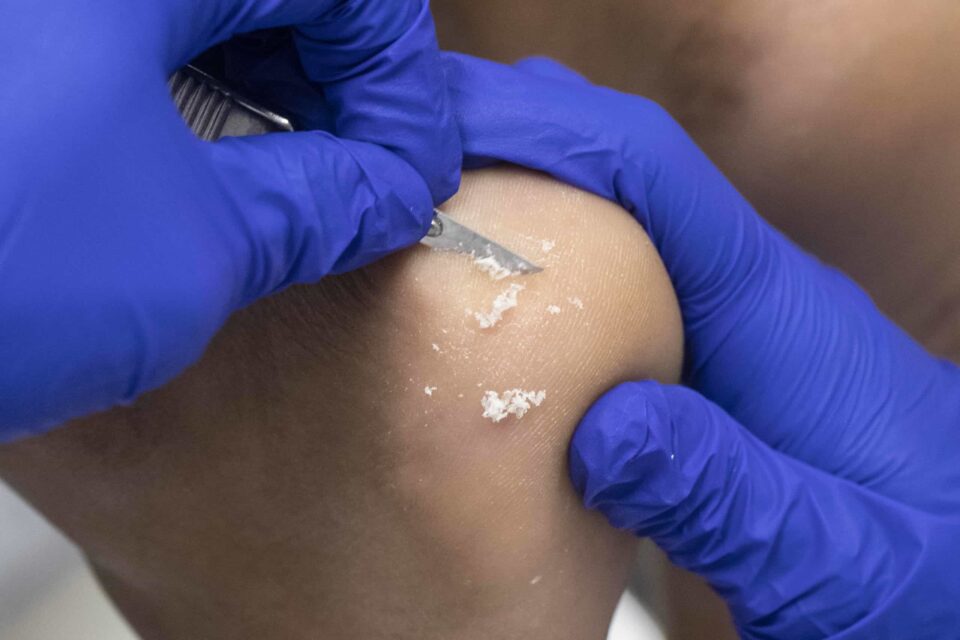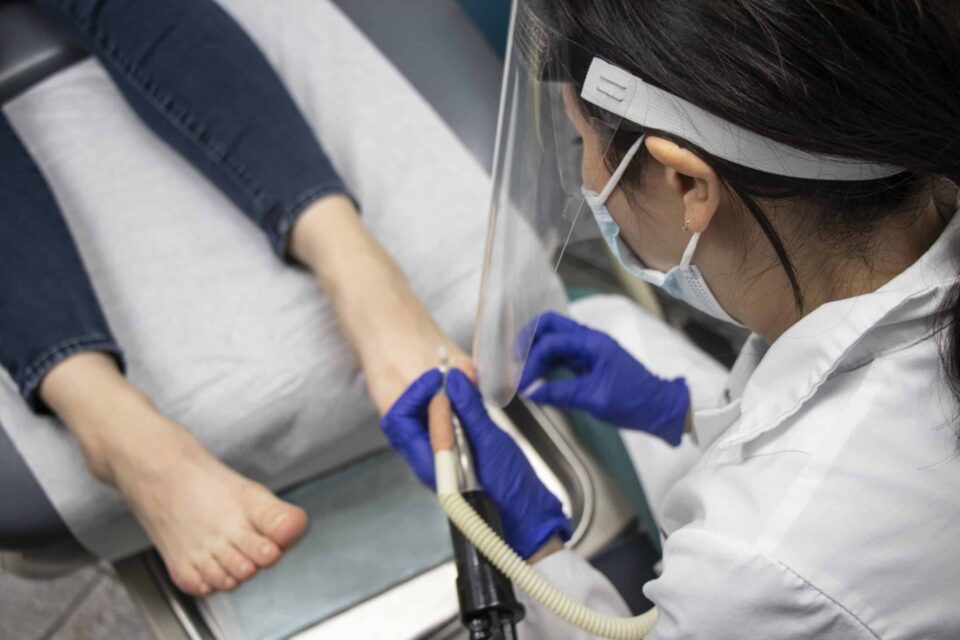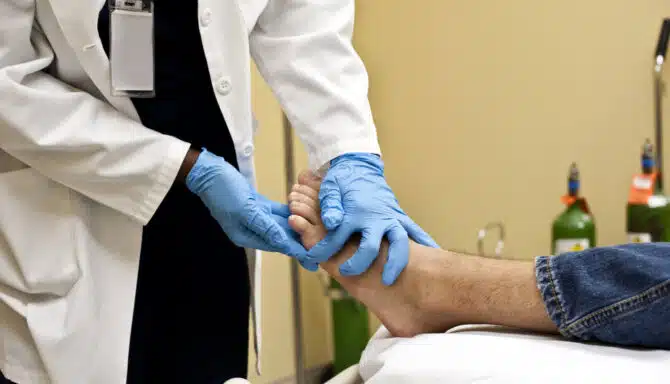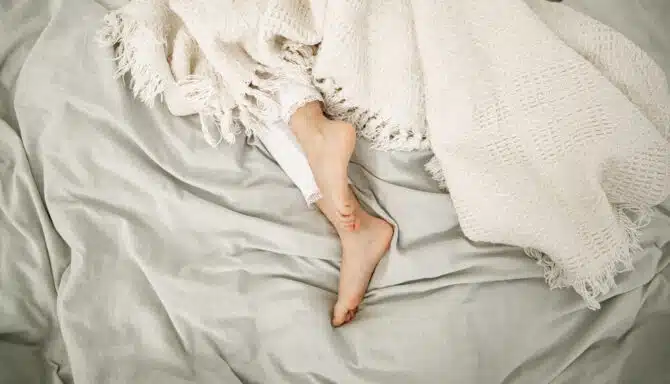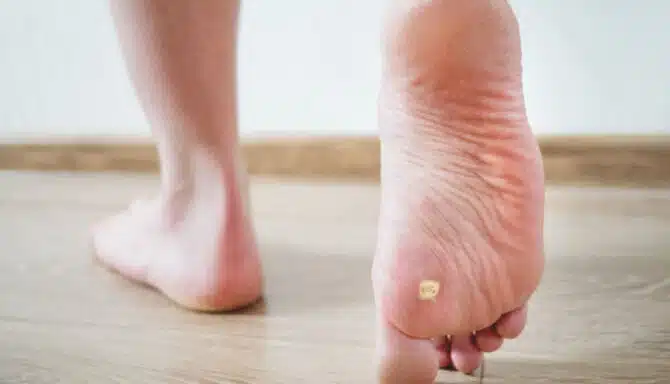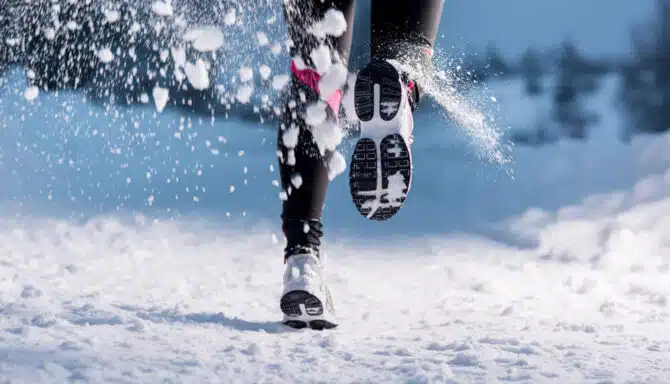March 6, 2025
Figuratively speaking, it’s a good thing to have “thick skin,” right? But if you have palmoplantar keratoderma, it’s a different story. This condition, sometimes shortened to PPK, refers to a group of foot skin disorders characterized by thick, rough, and yellowed skin on the hand palms and feet soles. These conditions can be either inherited or acquired. In today’s article, we’ll explore the symptoms, causes, and, most importantly, the treatment options available. This type of skin thickening may warrant a trip to a foot clinic and the expertise of a foot care professional, such as a Chiropodist or Podiatrist. However, successful treatment may depend on the underlying cause of the skin thickening.
What is Palmoplantar Keratoderma?
This condition combines two scientific terms: palmoplantar, which specifically refers to the skin on the soles of the feet and the palms of the hands, and keratoderma, a term for epidermis (skin) thickening. In less common cases, transgradient keratoderma can affect the top of the hands and feet. The feet are usually more severely affected than the hands.
Palmoplantar keratoderma (PPK) causes thickened skin on the palms and soles due to an overproduction of keratin, the protein that forms the outer layer of the skin. Normally, keratin helps protect the skin from friction, pressure, and environmental damage. However, in PPK, something disrupts the balance of keratin production and shedding, leading to excessive buildup.
This happens because of genetic mutations or external factors that affect how skin cells grow and mature. Inherited forms of PPK often involve mutations in genes that control keratin formation or the connections between skin cells. These mutations make the skin cells more resistant to breaking down, so they pile up instead of naturally shedding.
Since the palms and soles experience the most pressure and friction in daily life, they are especially prone to this excessive keratin buildup. Over time, the thickened skin can cause pain or become hard and cracked, depending on the severity of the condition. Some types can also cause blisters to form.
Types of Palmoplantar Keratoderma and Associated Symptoms
https://www.youtube.com/shorts/-iNFLGednYY
Genetic (hereditary) keratoderma is usually divided into three main categories: diffuse, affecting the entire hand palm and foot sole; focal, where thickening is limited to pressure points; and punctate, which appears as small, hard lesions. Some genetic PPKs - particularly diffuse - are syndromic, meaning they are associated with other health conditions and additional symptoms, ranging from hearing loss to nail abnormalities to internal organ damage.
Acquired PPK, on the other hand, is always syndromic and develops later in life due to external factors such as infections, inflammatory diseases, or underlying systemic conditions like internal malignancies. Acquired forms may be easier to treat since you and your healthcare team can address the underlying cause. Acquired PPK is also more common than genetic, since there are more causes and risk factors associated with it.
Most types of PPK cause varying degrees of thick skin, potential foot odor (as a result of sweat combined with thick skin) and yellow/discoloured skin.
Genetic PPK Types and Symptoms
Diffuse PPK
This form presents with even thickened skin on the palms and soles, often with a red border at the edges. Symptoms typically appear in early childhood and may include excessive sweating (hyperhidrosis). The thickening is usually confined to the palms and soles, without extending to the tops of the hands or feet.
Focal PPK
This type is characterized by linear (striate) thickened areas on the palms and soles, often following the lines of skin tension. It is typically caused by mutations in genes encoding desmosomal proteins, which are crucial for cell adhesion. A specific type of focal PPK called Pachyonychia Congenita is a rare genetic disorder that can also cause thick toenails.
Punctate PPK
This form is characterized by multiple small, hard, corn-like lesions scattered on the palms and soles. It is associated with mutations in genes that play a role in skin cell function.
Acquired PPK Types and Symptoms
PPK from Infections (syphilis, etc)
Rough, scaly and yellow thickening on the palms and soles.
May come with a rash or other symptoms affecting the whole body.
Clears up when the infection is treated.
PPK from Inflammatory Skin Conditions (psoriasis, eczema)
Thickened, inflamed skin with redness and scaling.
Can extend beyond just the palms and soles.
Often improves with medicated creams or treatments that calm the immune system.
PPK Linked to Other Health Conditions (cancer, hormone disorders)
Yellow thickening of the palms and soles that appears suddenly in adulthood.
Can sometimes signal an underlying health issue, like cancer.
Needs further medical evaluation to check for possible internal diseases.
What is the Difference Between Palmoplantar Keratoderma and Calluses?
PPK is not the only cause of skin thickening on the feet and hands. In fact, it is more rare than another common culprit: calluses. But how do you know which condition you have?
Calluses are localized areas of thickened skin that develop as a protective response to repeated friction or pressure. Commonly found on individuals who are physically active or spend long hours wearing ill-fitting shoes, they are much less severe than PPK.
PPK tends to be thicker and more noticeable, alarming and unsightly than calluses, often covering a larger, symmetrical area on the palms and soles. It can appear hard and more yellow, or red and flaky. In some PPK cases, you may observe a red band at the edges of the thickened skin. Calluses can have a more mild appearance (but not always; they can sometimes be thick and painful!), with some people not even realizing they have them.
Does that mean that PPK is the same as having excessive calluses? Not exactly. Calluses are only caused by friction and pressure----whereas PPK always has a driving force behind it, whether it's a genetic mutation or the result of an illness.
https://www.youtube.com/shorts/yBACD8bUim0
Palmoplantar Keratoderma Treatment: Can a Chiropodist or Podiatrist Help?
While there is no outright cure for certain forms of PPK, Chiropodists and Podiatrists can help manage symptoms, reduce discomfort, and improve mobility. This typically involves regular debridement (carefully removing excess skin), possibly prescribing medicinal products, and offering footwear advice to minimize friction and pressure. The latter may also include prescribing custom orthotics to properly distribute pressure on the bottom of the feet, especially if the thickened skin is impacting daily life. Scheduling an initial assessment is a good start!
Naturally, since PPK can be linked to an underlying condition, more comprehensive care may be needed. A Chiropodist or Podiatrist might become a part of a broader team of healthcare professionals that can help you, including a dermatologist, your family doctor or other specialists trained to tackle the root cause. You may need advanced treatments such as topical retinoids, corticosteroids, or even laser therapy in some cases.
https://www.youtube.com/shorts/sBIdll7qylQ
January 23, 2025
There are plenty of myths about foot odor. From thinking it only happens in hot weather to assuming those who struggle with it must not bathe or shower, it’s a foot condition that can be difficult to understand and affect our confidence. You may also wonder if foot odor is a serious problem and when to see a foot specialist, like a podiatrist or chiropodist, about it. On the other hand, you may be able to tackle it on your own. Today we’ll talk in depth about when you might need some extra help with your foot odor.
What is Foot Odor?
https://www.youtube.com/watch?v=meO8VW1yxJ4
Foot odor is the unpleasant smell that arises from the feet. The main cause of foot odor is the excessive perspiration of the feet combining with bacteria, often occurring in areas where sweat accumulates the most, such as inside shoes or socks. This creates an ideal environment for bacteria to thrive.
Fun fact: human sweat itself is almost entirely odorless! Odors arise when it interacts with bacteria present on the skin, particularly on the soles and between the toes, forming odorous substances. This breakdown process produces an array of compounds, including acids, ammonia, and sulfur-based compounds, which are responsible for the characteristic smell.
Persistent Foot Odor Causes and How to Prevent Foot Odor
One condition that exacerbates foot odor is plantar hyperhidrosis, a condition where the sweat glands on the soles of the feet produce excessive amounts of sweat. When the feet sweat excessively, the increased moisture fosters a more conducive environment for the growth of bacteria, contributing to stronger foot odor.
This is a medical condition that often requires intervention to manage the excess sweating. Treatment options include topical antiperspirants, double layered cotton socks and Anticholinergic creams. A podiatrist or a chiropodist can also recommend absorbent insoles and give you advice on how to practice proper foot hygiene, which should include washing with an antibacterial soap, thoroughly drying, and applying foot powder or antifungal powder.
In addition to plantar hyperhidrosis, several other factors and health issues can contribute to foot odor:
Fungal Infections
Fungal infections, such as athlete's foot, thrive in warm, damp environments, which is why sweaty feet are more prone to infection. These infections can cause itching, burning, and peeling skin, alongside a musty odor due to the fungus feeding on skin cells.
Diabetes
Foot odor can be a serious concern for individuals with diabetes, as it might signal an infected wound or a diabetic ulcer, particularly in the toes or feet. Due to reduced circulation and nerve damage associated with diabetes, wounds can go unnoticed, and the risk of infection increases. The presence of odor may indicate that an infection is developing, which requires prompt medical attention to prevent complications such as cellulitis or gangrene.
Poor Circulation
Poor circulation can lead to excessive sweating as the body tries to regulate temperature. However, insufficient blood flow also prevents the proper removal of toxins, causing a build-up of bacteria that contributes to foot odor. It’s important to try and improve your circulation as much as possible: one way you can do so is with exercises that help with circulation in the winter time.
Hormonal Imbalances
Conditions such as pregnancy, menopause, or thyroid disorders can cause hormonal changes that influence sweat production. These fluctuations in hormones can trigger excessive sweating, creating an environment that supports bacterial growth and results in stronger foot odor.
Lifestyle and Diet
Poor foot hygiene or wearing shoes that do not allow the feet to breathe can trap moisture and heat, promoting bacterial growth that causes odor.
It’s important to wear breathable shoes to ensure excess moisture doesn’t build up and disrupt a healthy shoe environment. Moisture wicking socks are another great way to be vigilant against foot odor, in addition to regularly changing your socks throughout the day and keeping your feet nice and clean, which we discussed earlier.
Diets high in spicy foods, alcohol, or caffeine can also increase sweating and contribute to foot odor.
Is My Foot Odor A Serious Problem?
In general, foot odor is harmless and can be managed with good hygiene. But it can become a serious issue when it signals an underlying health problem, especially if it's persistent, worsens over time, or has a particularly foul smell that differs from the typical cheesy, vinegary or sweaty smells we all recognize in foot odor.
When combined with other symptoms such as redness, swelling, pain, or itching, it could indicate an infection like athlete's foot or cellulitis. If the odor is accompanied by open sores, blisters, peeling skin, or wounds that don't heal, it's important to pay attention to these signs as they may point to infections or worsening diabetic neuropathy that requires a prompt visit with a chiropodist or podiatrist. This is also crucial if your foot odour is accompanied by other concerning symptoms, such as a change in skin colour. Typically, it will be obvious if a pungent smell is radiating from a wound instead of just your feet, so in this case, treat the odor as an urgent matter.
When To See A Foot Specialist For Foot Odor
https://www.youtube.com/shorts/sBIdll7qylQ
If you’re unsure whether your foot odor is linked to a more severe issue, it’s a good idea to consult a healthcare professional for a thorough evaluation, and see a chiropodist at a foot clinic.
These experts can help identify the root cause of persistent odor, whether it’s fungal, bacterial, or linked to a medical condition like diabetes or plantar hyperhidrosis. They can also recommend effective options tailored to your specific needs, such as prescription topical solutions, high-quality creams and powders, advice on managing excess sweat, footwear recommendations, and more. Foot specialists are trained to spot subtle signs that might go unnoticed and can offer targeted solutions and tailored treatment plans that go beyond home remedies.
Seeing a foot specialist can also help you better manage foot odor linked to chronic conditions. For example, if you have diabetes or poor circulation, a chiropodist can advise you on preventative measures to avoid complications like infection or wound degradation. If you’re experiencing frequent or severe foot odor, don’t wait for it to escalate—getting professional help early can ensure that any underlying issues are addressed promptly and effectively.
December 26, 2024
While corns and plantar warts may look alike at first glance, they differ significantly in their causes, symptoms, and treatments. If you’re unsure about whether you have a corn or a plantar wart, visiting a chiropodist can help you receive an accurate diagnosis and appropriate treatment. Whether it’s corn enucleation or wart removal, timely intervention with a podiatrist or chiropodist at a foot clinic will ensure your feet stay healthy and pain-free.
What are Corns?
Corns are small, thickened areas of skin that develop in response to repeated friction, pressure, or irritation. They usually develop on the feet, particularly in weight-bearing areas such as the tops and sides of the toes or on the soles. Foot corns are essentially the skin's way of protecting itself from friction, forming as a shield for the underlying skin. The hardened layer is your body’s method of preventing skin ulceration.
There are different types of foot corns, each with its own characteristics. Hard corns are small, round, and painful, typically found on the bottom of the foot due to abnormal pressure or friction. Soft corns, which are usually located between the toes, are white and rubbery due to moisture. Seed corns are tiny, painless and appear on the sole of the foot.
Corns: Causes, Risk Factors and Symptoms
Generally speaking, corns are caused by inefficient foot mechanics which lead to excessive pressure and friction. They may also be linked to other foot conditions. For example, an abnormal gait pattern due to flat feet can lead to pressure points. This can then cause corn formation in vulnerable areas of your foot. Here are some key risk factors and causes:
Wearing high heels often.
Wearing shoes that are the wrong size.
Wearing uncomfortable shoes.
Not wearing socks with your shoes.
Irregular walking motion / abnormal gait.
Corn Symptoms Include:
Thickened, hardened areas of skin on the toes, sides, or soles of the feet
Rough or waxy texture on the affected area
Localized pain or tenderness, especially when pressure is applied
Yellowish or greyish appearance, sometimes with a central core
Discomfort during walking or wearing tight-fitting shoes
Interference with daily activities in severe cases
What are Plantar Warts?
Plantar warts are localized skin infections caused by certain strains of the human papillomavirus (HPV), specifically types 1, 2, and 4 which target the epidermis—the outermost layer of the skin. The strain of HPV can sometimes determine how painful a plantar wart may be. For example, HPV 1 may cause deeper, more painful warts, while HPV 2 causes more superficial ones.
These warts develop on the plantar surface of the foot, which includes the sole and heel, areas that bear significant weight and endure pressure during standing and walking. Unlike some other HPV-related warts, plantar warts are non-cancerous and are confined to the feet, as the virus is adapted to thrive in the thicker, tougher skin found on the soles. Plantar warts can last anywhere from two months to several years, especially if left untreated.
For individuals with a healthy immune system, plantar warts are generally not a significant health concern. However, they can make activities like walking, standing, or running very uncomfortable and painful. The pressure exerted on the wart may cause irritation and discomfort, which causes hardened skin to build up over the wart. The latter is also a big reason people confuse them with corns or calluses.
It’s important to seek treatment as soon as you notice any symptoms: Even if it's not interfering with your daily routine, it is still contagious so you can infect others. In addition, addressing these symptoms promptly with a foot specialist like a chiropodist or podiatrist can prevent further complications.
Plantar Warts: Causes, Risk Factors and Symptoms
Plantar warts are contagious and similar to fungal infections like athlete’s foot in that you can contract them by walking barefoot in public, moist spaces. Here are some more details on what activities or risk factors may lead to plantar warts:
You have a weakened immune system. Many people's immune system can recognize and fight off the HPV virus before warts form. However, people with a poorly functioning immune system are more susceptible as their body is less equipped recognize and fight the HPV virus. People who are immunocompromised may take longer to fight the virus, meaning that that the warts will take longer to treat.
You’re 65 or older, or a child or teenager: Plantar warts can be more common in these age brackets. For children, their immune systems are still developing, and they’re more likely to share communal spaces like gyms and locker rooms. For seniors, the immune system may be compromised.
Environment exposure and being barefoot: Frequenting warm, moist environments like swimming pools, locker rooms, and communal showers increases exposure to HPV. These areas are ideal breeding grounds for the virus, making it easy to contract through bare feet. Walking barefoot on abrasive surfaces, like pool decks or gym mats, can also create micro-injuries that allow HPV to enter.
Skin cracks and abrasions: Any break in the skin, including cracks, blisters, or injuries, can act as an entry point for the virus.
Poor foot hygiene practices: Neglecting foot care, such as not cleaning feet thoroughly or allowing them to remain damp for prolonged periods, can create conditions favourable for infection.
Plantar Wart Symptoms Include:
Rough, thick circular patches that have similar colouring and shape to a cauliflower.
Warts that form on the heels, around your toes, or on the ball of the foot.
Other discoloration: brown, pink, yellow or gray.
“Wart seeds” – which look like a small black dot in the wart
Pain, tenderness and general discomfort.
Bleeding.
Both cluster and solitary growth are possible.
Corns and Plantar Warts: Key Differences
While warts and corns can look and feel very similar, the main difference lies what causes them. Corns are caused by the body's response to excessive friction against the skin, whereas plantar warts are caused by strands of the contagious HPV virus.
Here are two additional ways to help distinguish between corns and plantar warts.
Pain type: Plantar warts may cause pain when pinched from the sides, whereas corns are tender when pressure is applied directly to them.
Appearance: Corns have a “waxy” yellowish appearance, whereas plantar warts often have a black dot in the centre. And while difficult to tell, warts go much deeper into the skin than corns.
Location: Corns tend to occur in the non-weight bearing parts of the foot, like between or on top of the toes. Conversely, plantar warts tend to occur on the weight-bearing parts of the foot, like the ball of the foot.
Multiplication and Spreading: Corns are concentrated in pressure-points on the foot and don't typically "spread". Plantar warts, however, can multiply and spread to other parts of the foot if the virus is allowed to grow unchecked.
Corns and Plantar Warts: Treatment and Prevention
https://www.youtube.com/shorts/TDV3Dd98oOM
Many services performed by a chiropodist or podiatrist are available at a foot clinic and can target both conditions.
How to Treat Plantar Warts
Plantar wart treatment requires a specialized approach. As they're caused by a virus, they cannot simply be "removed". Rather, depending on the severity of the warts, the frequency of re-exposure to the virus, and the person's immune system, warts can take multiple treatments spanning over several months.
Here are the different treatment options for plantar warts, in order from most conservative to most aggressive:
Salicylic acid, a common over-the-counter treatment, gradually softens the wart and sheds layers of skin. Although it is not painful, it may take longer to see results. For a faster alternative, a chiropodist can prescribe a higher-strength salicylic acid solution to be applied at home with follow-up visits. The chiropodist will then routinely debride the dead skin covering the wart to allow better penetration of the medication.
Cryotherapy, or freezing, is another standard method where liquid nitrogen is applied to the wart to freeze and destroy the wart tissue. This treatment may cause temporary pain and requires multiple sessions, each 2 -3 weeks apart.
Cantharone (canthacur) is an acid applied by a chiropodist that causes a blister to form and the wart to lift off the skin, typically within a few days. Although this treatment is more effective and doesn't take as long as cryotherapy, the resulting blister may be uncomfortable. This is the most common treatment used by chiropodists. It requires multiple treatments, each 2 - 3 weeks apart (though typically not as many as cryotherapy).
Wart needling is a surgical procedure. It involves puncturing the wart multiple times with a sterile needle to trigger the body's immune response. It is a good option for multiple or resistant warts.
Finally, excision involves surgical removal of the wart. It is reserved for stubborn warts that don't respond to other treatments, and has a risk of scarring. It is seldom used.
How to Treat Corns
A chiropodist or podiatrist can treat corns by gently shaving down the thickened skin with sterilized tools. The treatment is effective, safe, typically painless, and will discomfort without risking infection.
Inserts and custom orthotics can also play a significant role in managing and preventing recurrent corns. Custom orthotics are specially designed to provide support and distribute pressure evenly across the foot. This reduces the friction and pressure points that can lead to corns. Over-the-counter insoles and inserts can also provide extra cushioning and improve the fit of shoes, offering relief and preventing further irritation.
Self care can also go a long way. Soaking corns in warm water softens them, making it easier to reduce its size. It's also important to moisturize your feet regularly to make the skin stronger and more flexible, which will reduce its sensitivity to friction and hardened skin buildup. Toe pads or non-medicated patches can also protect corns from further irritation and promote healing.
Lastly, but equally important, you must find the right shoes to wear for each season and choose shoes with a proper fit. This can help prevent the pressure and friction that causes foot corns. A complimentary shoe fitting at a foot clinic can help!
https://www.youtube.com/shorts/R7GV0GbKhvQ
December 5, 2024
Seasonal changes can significantly impact diabetic foot health. In the summer, heat and sweating can create challenges, while cold temperatures and wet weather during the winter present other risks. That's why diabetic winter foot care is so important. Today we'll talk about:
You'll learn all about:
The connection between diabetes and foot health
The importance of diabetic foot care in the winter
Our Foot Specialists' top tips for diabetic winter foot care
The Connection Between Diabetes and Foot Health
https://www.youtube.com/shorts/4P3UiDSFzr4
Approximately 800 million adults worldwide have diabetes. It isn’t often immediately recognized as a foot condition on its own, but a serious issue called diabetic foot (a broad term encompassing a wide range of problems) can occur. As a result, foot care should be a top health priority for people with diabetes.
Reduced Blood Flow
People with Diabetes are at risk of developing neuropathy. There are four types, with peripheral symmetric neuropathy (which affects the feet and hands) being the most relevant for diabetes patients.
This condition develops when elevated glucose levels lead to a series of metabolic and vascular changes that impair nerve function. Over time, excess glucose triggers oxidative stress and inflammation, damaging the small blood vessels (microvasculature) that supply the nerves. Without adequate blood flow, nerves are deprived of oxygen and essential nutrients, resulting in their gradual deterioration.
Reduced Sensation
This damage primarily affects sensory nerves, which are responsible for transmitting pain, temperature, and pressure signals to the brain. This progressive loss of sensation makes it difficult for individuals to detect injuries or changes in their feet, such as cuts, blisters, or pressure points. These minor skin issues can turn to diabetic ulcers (open sores or wounds) when ignored.
Reduced Immune Function
Diabetes can also contribute to ulcer formation due to its impact on the immune system. High blood sugar levels over time impair the function of white blood cells, which are essential for fighting infections and promoting wound healing. When blood glucose levels are consistently elevated, it reduces the ability of these immune cells to properly respond to bacteria or other pathogens. This makes it more difficult for the body to prevent wounds that may develop on the feet - including minor cuts, blisters, pressure sores or even calluses - from getting infected. As a result, these small injuries are more likely to become infected, and ultimately lead to diabetic ulcers.
The impaired immune function, combined with poor circulation and reduced sensation, creates a perfect environment for these infections and ulcers to progress, further delaying healing and increasing the risk of severe complications, such as deep tissue infections or gangrene.
Why is Diabetic Foot Care Important in the Winter?
Cold and wet weather can impact everyone's feet, but winter can have a more severe effect on people with diabetes.
Cold Weather and Diabetes: Risk Factors
Low temperatures: Cold air can reduce circulation by constricting blood vessels, particularly in the lower extremities, making it even more difficult for already-compromised vessels to supply the feet with sufficient oxygen and nutrients. This further impairs the body’s ability to heal wounds.
Wet conditions: Snow, rain and sleet getting into your shoes and socks is a recipe for disaster for diabetics. You can develop blisters, sores and infections (which are all ulcer risks) when you let moisture build for too long.
Dry skin: On the other hand, it is also not ideal for your skin to be too dry. By nature, cold air is very dry. Indoor heating makes the air even dryer by extracting humidity. The lack of moisture in the air dries out the skin - including the skin on our feet. This makes calluses form faster and can lead to issues like cracked heels. And since diabetes impairs the body's ability to heal dry skin and cracked heels, the cracks can easily split open, get infected and turn into a diabetic ulcer.
Winter Foot Care for Diabetics
Podiatrists and chiropodists strongly advise individuals with diabetes to take extra care of their feet during the winter months due to the increased risks posed by the elements. If you have diabetes, keep reading to learn the best tips for winter foot care - all recommended by the foot specialists at our Toronto foot clinic.
Practice Skin Care
https://www.youtube.com/shorts/1-Sf43woLLE
Moisturizing your feet regularly is one of the most important steps to combat dry, cracked skin. However, our foot specialists also caution against using harsh creams full of chemicals and fragrances - especially if you have diabetes. Opt for medically respected products with natural ingredients, like Gehwol’s Lipidro and Dermal Therapy Heel Care, that replenish the natural amount of moisture in the skin while also healing cracks.
Only moisturize your feet after thoroughly cleaning and drying. Check out this ultimate guide to moisturizing your feet to master four easy steps. While you're at it, check out the best foot hygiene routine.
Perform Foot Stretches and Exercises
Movement is one of the most effective ways to manage diabetic foot concerns and counteract the impact of cold weather on blood flow. Low-impact cardio exercises such as swimming and walking can assist people in managing blood flow and sensation loss, respectively. Removing the elements of competition and high strain exertion found in other sports, and focusing solely on safety and motion, is a great way to encourage activity.
There are also targeted, low-impact and easy-to-perform foot stretches and exercises designed for people with diabetes. The goal is to stimulate blood circulation as much as possible while still considering any physical limitations. Below are three light exercises you can try from home, and while they may be hard to perform at first, practice makes perfect!
Toe Curls: Sit with your back straight, feet planted, and use a towel to scrunch your toes and pull it toward you, repeating five times per foot.
Figure Eights: Lift one foot while keeping the heel on the floor, move your foot in a "figure eight" motion, repeating five to 10 times per foot in each direction.
Single Leg Lifts: Stand with feet shoulder-width apart, hands on hips, and lift your left foot straight out in front, keeping your leg straight and foot flexed, repeating five times per foot.
To learn more about these exercises, check out the best stretches and exercises for diabetes.
Practice Moisture Control
Keep your feet reasonably dry as much as possible. This may mean changing your socks and shoes several times per day, and thoroughly drying your feet with a towel intermittently. While this can be annoying and easy to forget during the busy winter season, it’s important to stay on top of this with snow, sleet and rain posing an extra risk.
It’s important to not go overboard with too much direct heat penetrating your feet. While cozying up by the fire is safe on occasion, excessive heat can cause even more damage to the nerves. This is due to reduced sensation in diabetic individuals, which makes it harder to notice high heat and burns.
Below are the best ways to manage excessive moisture during the winter:
Wear moisture-wicking socks.
Change socks regularly, especially if they get wet.
Use foot powders and deodorants.
Choose breathable, well-ventilated shoes.
Choose shoes made with waterproof fabrics, like GORE-TEX. This fabric uses a membrane with pores small enough to block water but large enough to allow sweat vapor to escape. This creates a waterproof yet breathable barrier, keeping feet dry and comfortable.
Dry feet thoroughly with a towel after washing, especially between toes.
Avoid tight shoes that trap moisture.
Consider insoles with moisture-absorbing qualities.
Keep feet clean and dry before bed.
Perform Foot Inspections
At-home foot inspections are a good diabetic foot care measure in the winter (and in general) because they help identify potential issues like cuts, blisters, or signs of infection early, when they're easier to treat.
Check for cuts, blisters, or sores: Examine the entire surface of your feet for any visible signs of injury and skin perforation.
Look for changes in skin color or temperature: Check for any redness, swelling, or areas that feel unusually warm or cold.
Check your toenails and between toes: Look for ingrown toenails, cracked toenails and fungal infections,
Try Diabetic Socks
Compression stockings are a great way to enhance blood flow to the legs and feet, but they are not recommended for people with diabetes since they can do the opposite and restrict blood flow too much in the arteries. Instead, ask a podiatrist or chiropodist about diabetic socks and if they might work for you. They have several benefits, which are especially useful in the winter, including:
Antimicrobial treatment which prevents bacterial and fungal growth.
Slightly cushioned footbed for extra comfort and protection.
Loose, non-binding top band which rests comfortably around the ankles or calves, allowing more circulation.
Moisture-wicking and stretchy material.
Smooth toe area to prevent blisters and other skin irritation.
Choose the Right Footwear
https://www.youtube.com/shorts/R7GV0GbKhvQ
For diabetes patients, wearing proper footwear in the winter is essential for maintaining foot health.
Orthopedic shoes are an excellent choice, as they offer extra cushioning, arch support, depth, elasticity, adjustable straps and ample room to reduce pressure points and prevent blisters or sores.
High-quality winter footwear can also be effective, provided it offers warmth, water resistance, and moisture control properties to keep feet dry and comfortable. Here is what you should pay attention to:
Waterproof materials: As you already know, materials like GORE-TEX help maintain dryness by utilizing a membrane with microscopic pores. These pores are small enough to block water molecules, but large enough to allow vapor from sweat to escape. This technology effectively prevents external moisture, like snow or rain, from penetrating the footwear, keeping feet dry. The breathability of GORE-TEX also ensures that perspiration from the feet can escape, which prevents a buildup of moisture inside the shoe. This combination of waterproofing and breathability is essential for preventing cold and damp feet
Adequate insulation: This is crucial for maintaining warmth in winter footwear as insulation helps lock in warm air and retain body heat. Look for insulated winter shoes and boots that also let you maintain moisture control. And remember to let your feet air out after sweating in your boots all day to avoid excessive dampness.
Non-slip soles: For better traction on icy or slippery surfaces to avoid falls.
Cushioning and arch support: To provide comfort and reduce strain on the feet, especially when walking for extended periods.
Roomy toe box: To avoid friction and pressure on the toes, preventing blisters or sores.
Breathable lining: To allow moisture to escape and keep feet dry, reducing the risk of infections.
Adjustable closures: To ensure a secure fit without restricting circulation, particularly important for those with swelling or neuropathy.
In addition, custom orthotics can provide personalized support, improving foot alignment and alleviating pressure, further reducing the risk of diabetic foot complications.
Visit a Foot Specialist
https://www.youtube.com/shorts/qR3s05lUwyc
Our top tip for managing diabetic feet in winter? Book an appointment with a foot care provider, like a podiatrist or chiropodist, at a foot clinic.
At Feet First Clinic, our chiropodists are trained to:
Offer comprehensive education on how cold weather can affect diabetic feet.
Provide skin and nail care.
Provide wound care.
Offer custom orthotics services: assessments, casting, fittings and follow-up guidance.
Thoroughly inspect your feet and pinpoint potential issues (this can be difficult to fully achieve at home, since diabetes also affects eyesight).
Help you understand what winter boots or shoes you should wear, which you can then browse for at our store. A member of our staff can guide you through our options with a complimentary shoe fitting.
Discuss the benefits of products like diabetic socks, orthopedic slippers, moisturizers, and more, which you can then purchase at our store.
Contact our Toronto foot clinic to learn how a foot assessment can be your first step toward healthier, happier feet this winter!
November 30, 2024
Holiday shopping can feel like a daunting ordeal that takes away from all the fun. Your list is long, and you don't have ideas for some people - which is okay! But it doesn't have to cause so much stress. We've got you covered with our guide to the best foot care holiday gifts!
When you're stuck on what gift to get for your grandparents, friends, and other relatives, medical gifts may inspire you more than you realize. The health and wellness industry is known for producing excellent products, opening your mind to many gift options.
Gifts that promote foot health can help those with debilitating foot issues. But they can also help prevent foot conditions before they develop. And they're simply fun to use. We're talking foot creams, scrubs, and other luxurious products fit for a spa session!
The gifts we'll discuss today focus on both skincare and foot pain; they shine on their own and work well as stocking stuffers. But the best way to gift products from a foot care clinic is by compiling a foot care gift set! It's fun to try more than one product, and it gives loved ones the tools for a great self-care day. Let's take a look at our top picks!
Foot Care and Medical Gifts: Gift Guide 2024
Below is a general overview of our top foot care holiday gifts. But don't worry, we'll cover all the details.
Foot Exfoliators
Foot Creams & Moisturizers
Superfeet Insoles
Feet First Clinic Gift Certificates
Foot Exfoliators
Foot Scrubs & Foot Baths
Products like Gehwol's Herbal Bath are affordable medical gifts to raise your loved ones' foot care game to the next level. They're suitable for people of all ages and help exfoliate and soothe dry skin. Exfoliation prevents itchy, flaky dead skin from building up while simultaneously unclogging your pores. Exfoliating your feet weekly will help prevent and treat any callus buildup and cracked heels, while keeping your feet soft and moisturized.
But foot baths do even more for the body than you may realize. First, foot bath products combined with hot water help promote healthy blood flow, which can relieve pain from foot conditions like plantar fasciitis, bunions, etc. They can also warm your overall body temperature, which alleviates muscle tension, reduces stress, and may help prevent sickness or fight flu symptoms by strengthening your natural immunity (perfect for the winter!).
Helpful tip: It's best to start a spa session by bathing your feet, as it leaves a clean base for exfoliation and moisturizing by washing away bacteria and dirt.
Foot Files
Feet First Clinic's foot files are another great way to exfoliate your feet! You can gift someone a foot file as a stocking stuffer or as part of a gift box (throw in the Gehwol Herbal Foot Bath and some foot cream for the perfect foot care selection!).
But why do we need them?
Foot files remove hard, scaly dead skin from the bottom of the foot, making them feel silky smooth. Our foot files also have a smoothing side to buff and soften the skin. This allows you to customize and control where and how much skin you remove when exfoliating your feet (unlike the foot peels you see online). The perfect tool for concluding a luxurious at-home foot care session, you should give them some consideration as you shop for medical gifts.
View this post on Instagram
A post shared by Feet First Clinic (@feetfirstclinic_)
Foot Creams & Moisturizers
Gehwol Foot Creams
To restore the skin's natural barrier functions, you should always moisturize after soaking and exfoliating. Gehwol's Soft Feet Cream, Universal Foot Cream, and Med Lipidro Cream are just a few examples of medicinal moisturizers that work wonders. So why not gift them to someone you love? They'll get to enjoy smooth skin and fewer cracks and calluses.
If your loved one already has severely painful cracked heels, try gifting them Gehwol's Med Salve for Cracked Skin or Dermal Therapy Heel Care instead.
Dermal Therapy Heel Care
Hopefully, it's becoming clear that medical gifts can be more valuable than gifts that sit around collecting dust. And Dermal Therapy Heel Care is one of the best foot care holiday gifts around.
Cracked heels have the potential to burden everyone, from your best friend to your grandmother - dry skin doesn't discriminate! Severely cracked heels can make walking almost unbearable and cause swelling, inflammation, and bleeding. So if you're catching wind that someone you love is suffering, why not brighten their holidays by gifting them some relief?
Dermal Therapy helps skin cells deep below the surface absorb and lock in moisture, which fights cracked heels. It has the highest urea concentration (25%) of all the foot creams we carry. Urea is important because it works into the deeper layers of the skin to help skin both absorb and retain moisture. To top it off, dermal therapy is a moisturizer and exfoliator that removes dead cells, revealing fresh, young skin.
Superfeet Insoles
As far as medical gifts for healthy feet go, Superfeet insoles are a wonderful route to take. The general use of their most popular colour, green, is to provide extra support for people with flat feet, plantar fasciitis and other types of foot pain. And for those who want the same arch support as the flagship Superfeet Green, but with more cushioning and flexibility, you can get the Superfeet Run Cushion High Arch insoles - a new favourite and best seller at our Toronto foot clinic!
But if you have a loved one with more specific needs, worry not!
Superfeet produces several insoles with colours that indicate how they stand out. For example, Superfeet Berry is made specifically for women and comes with a slimmer heel and an arch length to fit the proportions of the female foot. And Superfeet Black is a versatile, low-profile option for people with flat feet. And that’s just the beginning!
October 28, 2024
Taking care of your feet during winter might require a little extra effort, but it’s essential for preventing discomfort and long-term issues. The cold weather can impact your feet in its own unique ways, just like hot weather can. Whether you’re dealing with dry, cracked skin or trying to avoid slippery conditions, being mindful of your foot health will keep you a step ahead of the cold.
5 Ways Cold and Wet Weather Can Impact Your Feet
Dry, cracked skin
Skin conditions
Reduced circulation
Stiffness and joint pain
Winter-related foot conditions
1. Dry, Cracked Skin
https://www.youtube.com/watch?v=1-Sf43woLLE
One of the first things you may notice during the winter is dry, cracked skin on your feet, especially your heels.
The chilly air and low humidity can quickly sap the moisture from your skin, leaving your feet feeling rough and sore. Heating indoors doesn’t help either, as it dries out the air, exacerbating the issue.
This is where cold weather foot care enters the picture! Since cracked skin can cause pain and even bleed, it becomes essential to protect your feet. This dryness isn’t just unsightly—if the cracks open up, it creates an easy pathway for infections. This can lead to debilitating pain and bleeding that makes walking difficult.
Regular moisturizing with a medical-grade foot cream is a straightforward way to combat dry feet and cracked heels. Look for products that contains a high urea concentration, which will help your skin replenish and retain lost moisture. It's important to use a foot cream instead of a regular moisturizer for your feet because the skin on your feet is thicker than the skin elsewhere on our body. Therefore, a regular body or facial moisturizer won't cut it - especially during the dry, colder months.
While you're at it, take your hydration to the next level by always remembering to drink your eight glasses of water per day. This advice still holds up today!
2. Reduced Circulation
Cold weather can mess with your blood flow, which can pose a problematic obstacle for foot health. When temperatures drop, blood vessels constrict to preserve heat, meaning less blood flows to your extremities. This is called vasoconstriction.
As a result, your feet may feel cold, numb, or even tingly. Poor circulation can also lead to prolonged healing times for cuts or blisters. This is concerning for diabetes patients with neuropathy who are already struggling with wound healing issues. That's why cold weather diabetic foot care should always include steps to monitor and improve blood flow— including daily foot inspections and easy foot exercises.
Wearing thermal socks and ensuring your feet are properly insulated can help combat the impact of reduced circulation. Just make sure your thermal socks fit comfortably with your fall and winter footwear: if your shoes or boots are too tight, it will reduce circulation and make your feet more susceptible to cold-weather complications (more on that below).
If you experience slippery conditions during winter, circulation issues can also increase your risk of falling or slipping. When your feet are numb, it’s harder to get a good sense of balance, so be cautious and wear shoes with good grip for FALL prevention.
Moving around can also help keep your blood flowing. So, if you’re out and about, take small breaks to wiggle your toes and stretch to maintain circulation. There are even targeted foot exercises you can try to help trigger healthy blood flow. In fact, you should do these more often in the winter than the summer.
3. Skin Conditions
https://www.youtube.com/shorts/xZ4RQwPmCzg
It might seem strange to consider blisters a winter problem, but they can definitely crop up due to cold weather foot care challenges.
Wearing heavy boots and thick socks can cause friction, leading to blisters on your heels or toes. This is why it’s extremely important for boots to fit snugly, but not be too tight. So if the socks you like to wear in the winter are causing your boots to constrict your feet, they don’t fit!
And if your feet are already dry, cracked, or dealing with reduced circulation, they’re even more susceptible to developing painful blisters. Combat this by ensuring your boots and sock combo always fit perfectly together, and opt for moisture wicking socks to go the extra mile.
Another common winter foot problem is athlete's foot. Though often associated with the hot summer months and public swimming pools, athlete's foot is no stranger to winter either. Athlete's foot thrives in wet, damp areas, so instead of crowded public summer pools, fungal infections change their habitat to the wet-from-the-snow environment inside your boots. And keep in mind, you can get athlete’s foot simply by coming into contact with someone who already has it.
When you’re tackling wet feet, whether it’s from snow or rain, you need to dry them thoroughly before putting on warm socks. Athlete’s foot loves moist environments, so making sure your feet are dry is key. If you start to notice itchy or peeling skin between your toes, it’s a sign that athlete's foot might be setting in. Treat it promptly with your Toronto chiropodist, who can provide the right antifungal products. Make sure you also keep your feet clean and dry and avoid sharing shoes and socks to protect your feet from a future infection.
4. Stiffness and Joint Pain
https://www.youtube.com/shorts/n46k32OZgco
Cold weather tightens your muscles, which in turn can lead to stiff joints. This discomfort can be particularly noticeable if you already have arthritis or any other joint-related issues. Without the right cold weather foot care, your feet can end up feeling stiff, which can affect your overall mobility. To help counteract this, regular stretching and low-impact exercises, such as foot rotations, can keep your joints limber.
This season also requires some extra attention to footwear. Choose shoes with ample support to keep your feet cushioned against the impact of walking on hard, cold surfaces. Slippery conditions can further aggravate joint pain because your body works overtime to stay balanced, putting extra pressure on your feet. Adding orthotics or insoles that provide added arch support can also reduce some of this strain and make your steps feel more cushioned and less jarring.
5. Winter Related Foot Conditions
Winter brings its own set of unique foot problems, including chilblains, frostbite, and Raynaud’s disease, all of which can make cold weather foot care a bit trickier.
Chilblains occur when your feet are exposed to cold, damp environments, causing painful, itchy red patches. This is particularly common in teenagers, or people who quickly reheat their feet after being in the cold, so it’s best to warm up slowly.
Frostbite is another concern in extreme cold, as it can severely damage your skin and tissues. Frostbite can occur more quickly than you might expect, especially if you don't protect your feet from the weather. Signs of frostbite include numbness, skin discolouration, and a hard, waxy texture. If you think you may be experiencing frostbite, it’s essential to seek medical help immediately. To prevent frostbite, be sure to layer up and wear weatherproof boots that keep your feet dry and warm.
Lastly, Raynaud’s disease can be exacerbated by cold weather. People with Raynaud’s experience an exaggerated response to cold, which restricts blood flow to the toes, leading to reduced circulation and making your feet even more vulnerable. Keeping your feet constantly warm and avoiding sudden temperature changes can help manage Raynaud’s symptoms, but if you experience persistent pain or numbness, you should consult a healthcare provider.
